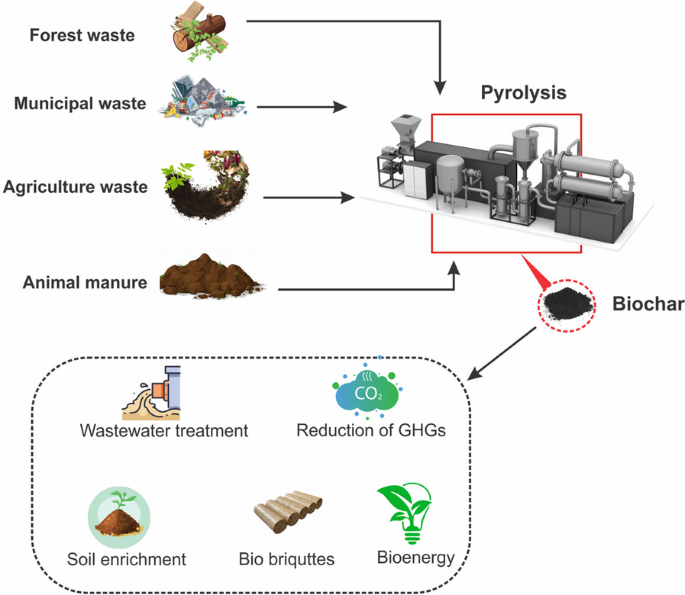Facts for UPSC Mains
Biochar-Led Carbon Drawdown for Sustainable Growth
- 12 Aug 2025
- 8 min read
Why in News?
With the Indian carbon market set to be launched in 2026, CO₂ removal technologies such as biochar are poised to play a pivotal role in reducing emissions and ensuring sustainable growth.
What are the Key Statistics Related to India's CO2 Emissions?
- Total Emissions: India contributes only 4% of global cumulative GHG emissions (1850–2019), with per capita emissions at about one-third of the world average.
- India reduced its GDP emission intensity by 36% (2005–2020).
- India is the 3rd largest emitter of greenhouse gases after China and the USA.
- Emission Hotspots:
- India’s power sector, dominated by coal-based thermal plants, is the largest source of CO₂ emissions, contributing about 50% of the country’s fuel-related emissions.
- The transport sector, especially road transport, accounts for around 12% of India’s energy-related CO₂ emissions.
- These sectoral trends underscore the urgency of advancing scalable CO₂ removal pathways, with solutions like biochar offering significant potential to offset emissions and support India’s low-carbon transition.
What are the Potential Applications of Biochar?
- About: Biochar is a carbon-rich charcoal produced through pyrolysis of agricultural residue and organic municipal waste.
- India produces over 600 million tonnes of agricultural residue and 60 million tonnes of municipal waste yearly. Much of this is burned or dumped, causing air pollution and greenhouse gas emissions.
- Utilizing 30-50% of this waste for biochar could remove around 0.1 gigatonnes of CO₂-equivalent each year.
- Potential Applications of Biochar:
- Carbon Capture: Biochar’s stable structure enables it to sequester carbon in soil for 100 to 1,000 years, making it an effective long-term carbon sink that also enhances soil organic carbon and aids in the restoration of degraded soils.
- Modified biochar can adsorb CO₂ from industrial exhaust gases, but its efficiency is currently lower than conventional carbon capture technologies.
- Power Generation: Biochar production through pyrolysis in India can generate approximately 20–30 million tonnes of syngas and 24–40 million tonnes of bio-oil as valuable byproducts.
- Syngas can produce 8–13 Terawatt-hour (TWh) of electricity annually.
- Bio-oil can substitute 12–19 million tonnes of diesel or kerosene, helping reduce crude oil imports and cutting fossil fuel emissions by over 2%.
- Agriculture: Applying biochar improves water retention, especially in semi-dry and nutrient-depleted soils. This leads to a 30-50% reduction in nitrous oxide emissions, a potent greenhouse gas with 273 times the warming potential of CO₂, making its mitigation critical for climate action.
- Construction Sector: Incorporating 2-5% biochar into concrete improves mechanical strength, increases heat resistance by 20%, and captures approximately 115 kg of CO₂ per cubic metre.
- Wastewater Treatment: Biochar is a cost-effective way to clean polluted water. India produces over 70 billion litres of wastewater daily, but 72% remains untreated.
- Carbon Capture: Biochar’s stable structure enables it to sequester carbon in soil for 100 to 1,000 years, making it an effective long-term carbon sink that also enhances soil organic carbon and aids in the restoration of degraded soils.
What are the Other Key CO₂ Removal Technologies?
- Bio-based Solutions:
- Afforestation & Reforestation: Large-scale tree planting to absorb atmospheric CO₂.
- Agroforestry: Integrating trees with crops/livestock for carbon sequestration and livelihood benefits.
- Soil Carbon Sequestration: Practices like conservation tillage and cover cropping to enhance soil organic carbon.
- Ocean-based Solutions:
- Artificial Upwelling/Downwelling: Moving nutrient-rich waters to surface or transporting CO₂-rich surface waters to depths.
- Seaweed Cultivation & Sinking: Farming fast-growing seaweeds for carbon storage via harvest or sinking.
- Bioenergy with Carbon Capture and Storage (BECCS): It combines biomass energy with CO₂ capture and geological storage, enabling renewable power with net negative emissions.
- Direct Air Capture (DAC): It involves chemical processes extracting CO₂ directly from air for underground storage or product use.
- Eg: Climeworks (Switzerland), Carbon Engineering (Canada).
- Carbon Capture, Utilisation, and Storage (CCUS): CCUS captures CO₂ from industrial emissions for reuse (synthetic fuels, building materials) or storage.
Keywords for Mains
- Black Gold for Green Future: Carbon sequestration & improved soil health
- Nature’s Carbon Vault: Long-term, stable carbon storage with environmental co-benefits
- Bioenergy Trifecta: Biochar, syngas, and bio-oil produced via pyrolysis
- Circular Carbon Economy: Closing the loop in energy and material use
- Farm to Fuel: Decentralized rural biochar units generating local energy and livelihoods
Conclusion
Promoting biochar and other CO₂ removal technologies can turn the climate challenge into sustainable growth opportunities, helping India meet its Paris Agreement goals and build a low-carbon, climate-resilient future.
|
Drishti Mains Question: In light of the recent push towards biochar production in India, discuss the role of CO₂ removal technologies in mitigating climate change. What are the challenges and opportunities associated with their large-scale deployment? |
UPSC Civil Services Examination, Previous Year Question (PYQ)
Q. What is the use of biochar in farming? (2020)
- Biochar can be used as a part of the growing medium in vertical farming.
- When biochar is a part of the growing medium, it promotes the growth of nitrogen-fixing microorganisms.
- When biochar is a part of the growing medium, it enables the growing medium to retain water for a longer time.
Which of the statements given above is/are correct?
(a) 1 and 2 only
(b) 2 only
(c) 1 and 3 only
(d) 1, 2 and 3
Ans: (d)
Q. With reference to the usefulness of the by-products of the sugar industry, which of the following statements is/are correct? (2013)
- Bagasse can be used as biomass fuel for the generation of energy.
- Molasses can be used as one of the feedstocks for the production of synthetic chemical fertilizers.
- Molasses can be used for the production of ethanol.
Select the correct answer using the codes given below:
(a) 1 only
(b) 2 and 3 only
(c) 1 and 3 only
(d) 1, 2 and 3
Ans: (c)








